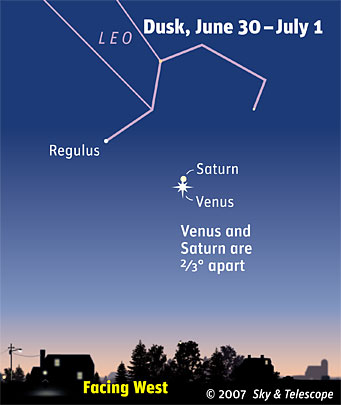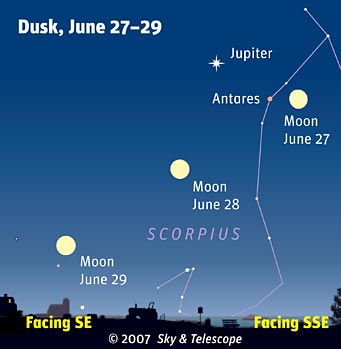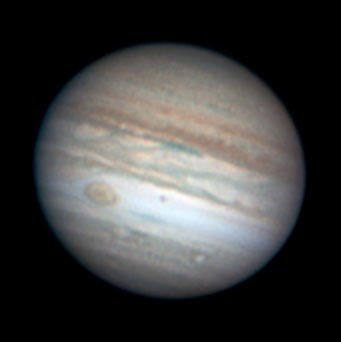Some daily events in the changing sky for June 22 – 30.

Don't miss the Venus-Saturn conjunction on the 30th! Mark your calendar.
Sky & Telescope diagram
Friday, June 22
Saturday, June 23
Sunday, June 24
Monday, June 25
Tuesday, June 26
Wednesday, June 27
Thursday, June 28
Friday, June 29
Saturday, June 30

The Moon passes Jupiter and Scorpius as it waxes toward full. (These scenes are drawn for the middle of North America. European observers: move each Moon symbol a quarter of the way toward the one for the previous date. For clarity, the Moon is shown three times actual size.)
Sky & Telescope diagram
Want to become a better amateur astronomer? Learn your way around the constellations. They're the key to locating everything fainter and deeper to hunt with binoculars or a telescope. For an easy-to-use constellation guide covering the whole evening sky, use the big monthly foldout map in each issue of Sky & Telescope, the essential magazine of astronomy. Or download our free Getting Started in Astronomy booklet (which only has bimonthly maps).
Once you get a telescope, to put it to good use you'll need a detailed, large-scale sky atlas (set of maps; the standard is Sky Atlas 2000.0) and good deep-sky guidebooks (such as Sky Atlas 2000.0 Companion or the enchanting though somewhat dated Burnham's Celestial Handbook). Read here how to use them most effectively.
More beginners' tips: "How to Start Right in Astronomy".
This Week's Planet Roundup
Mercury is hidden in the glare of the Sun.
Venus (magnitude –4.5, at the Cancer-Leo border) is the brilliant "Evening Star" in the west during twilight. Watch fainter Saturn closing in on it each day! See "Saturn" below.
Mars (magnitude +0.8, crossing from Pisces into Aries) is gradually getting higher in the eastern sky before dawn. In a telescope, it's still just a tiny blob 6 arcseconds wide.

Jupiter's Great Red Spot stands in striking contrast to its white surroundings this observing season. Sky & Telescope's Sean Walker shot this stacked-video-frame image from his home in New Hampshire around midnight EDT on the night of June 14–15, using a 12.5-inch Newtonian reflector at about f/40. The seeing was excellent despite Jupiter's rather low altitude in the sky as seen from his latitude of 43° north.
S&T: Sean Walker
Jupiter (magnitude –2.5, in southern Ophiuchus) was at opposition on June 5th. It glares in the southeast at dusk and dominates the south by 11 p.m. daylight saving time. Antares, less bright, sparkles 6° to Jupiter's lower right. These two will be evening companions all summer.
Saturn (magnitude +0.6, in Leo) is in the west during evening, closing in on dazzling Venus from the upper left. The gap between them shrinks from 6° on the 22nd to just 0.7° at their conjunction on the 30th!
Regulus, less bright at magnitude +1.4, is 8° to Saturn's upper left. And look north (upper right) of Regulus by 8° for 2nd-magnitude Algieba (Gamma Leonis).
Uranus (magnitude 5.8, in Aquarius) and Neptune (magnitude 7.9, in Capricornus) are well up in the southeast and south, respectively, before the first light of dawn.
Pluto (magnitude 13.9, in the northwestern corner of Sagittarius) is not far from Jupiter in the south in late evening (it was at opposition on June 18th). Finder charts for Uranus, Neptune, and Pluto are in the July Sky & Telescope, page 60.
All descriptions that relate to your horizon — including the words up, down, right, and left — are written for the world's midnorthern latitudes. Descriptions that also depend on longitude (mainly Moon positions) are for North America. Eastern Daylight Time (EDT) equals Universal Time (UT, UTC, or GMT) minus 4 hours.
To always get the up-to-date Sky at a Glance, bookmark this URL:
http://SkyTonight.com/observing/ataglance .
 0
0
Comments
You must be logged in to post a comment.